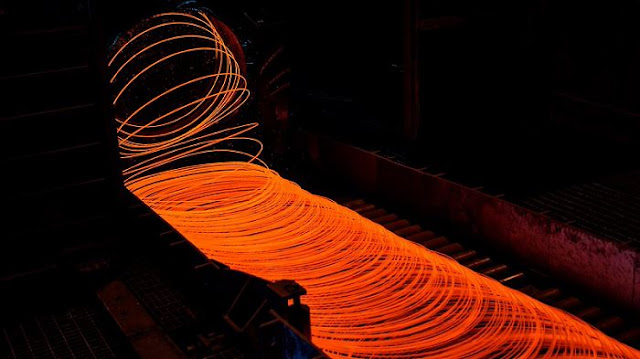High-speed Wire Rod Mill Production Line Process Flow
Billet preparation: 150 mm *150 mm *14 000 mm continuous casting billet.
Reheating furnace: The billet is heated to austenite temperature to facilitate rolling.
High-pressure water descaling: After the billet is heated in the reheating furnace, before entering the roughing rolling mill, it is necessary to descaling with high-pressure water to remove the oxide scale and secondary oxide scale on the billet surface, so as to avoid defects on the pressed surface.
Roughing mill, medium rolling mill, and finishing rolling mill rolling: the size of finished products, including 6 roughing rolling mills, 6 medium rolling mills, 4 pre-finishing mills, 10 finishing mills, a total of 26 rolling mills on this high-speed wire rod mill production line.
Flying shear head and tail: Before entering each set of rolling mills, the work of cutting head and tail must be carried out in order to remove the head with too low temperature to avoid damage to the roll surface and prevent the head of the rolling piece from being stuck in the inter-stand guide device. The stuck shear is used to crush and break the rolling event before the medium rolling mill, the pre-finishing mill and the finishing mill in the accident state.
Water cooling: In order to reduce the rolling temperature entering the finishing mill, a water tank is set before the finishing mill to control the finishing temperature.
Rolling: Rolled wires are rolled into rolls after cooling through water, forming loose rolls through spinning.
Stelmore uncoiled cooling: The cooling speed of the controlled cooling line is controlled according to different steel grades and product uses, so as to obtain the corresponding product quality.
Finishing and transportation: including coiling, dressing, inspection, sampling, baling and rolling, weighing and hanging tags, using the coiling device to collect loose rolls, and hanging them on the C-hook on the P-S transport line, completing the process of coiling, dressing, inspection, sampling, baling and rolling, weighing and hanging tags in turn, and then unloading and entering the warehouse.
Since 1989 Hani Tech has been always involved in design, engineering, manufacturing and installation of complete hot rolling mill plant for long products (re-bars, SBQ bars, wire rod, small and medium sections), as well as revamping and upgrading of existing plants.
Hani Tech is the one-stop manufacturer & supplier able to design, manufacture, install and commission your hot rolling mill plant from A to Z.
Please contact stella@hanrm.com for a quotation.
And free send inquiry to us.
Email: stella@hanrm.com stellarollingmill@gmail.com
Whatsapp/Wechat:+8615877652925

















